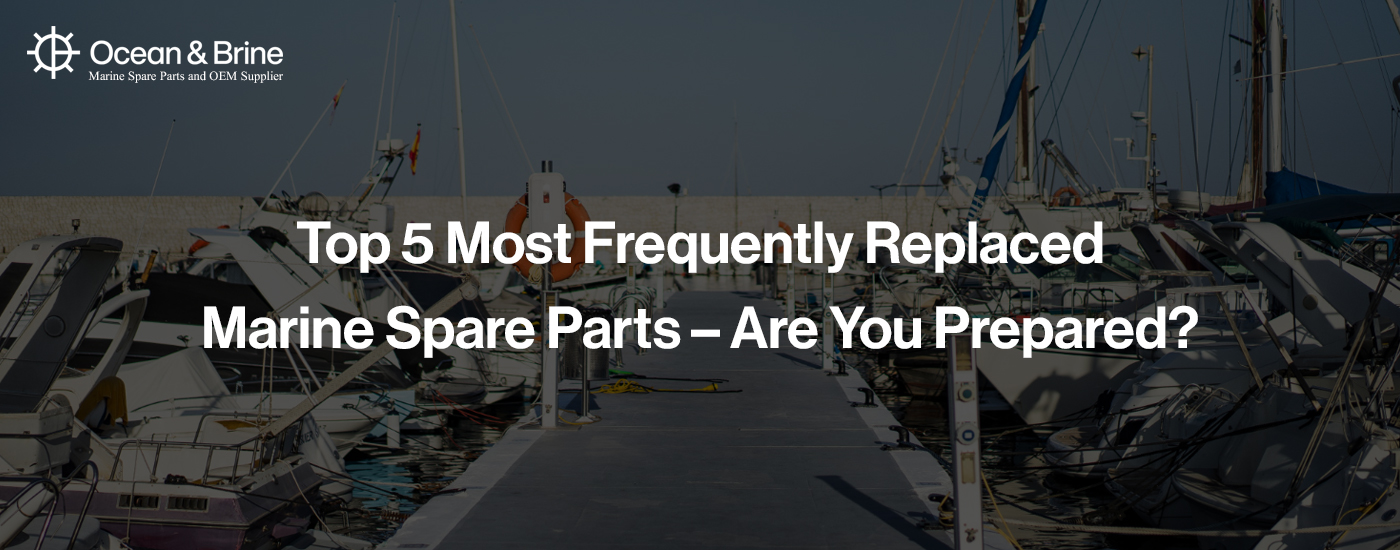Marine spare parts are replacement components and accessories used for the maintenance, repair, and safe operation of ships, as well as other marine vessels. These parts are essential to ensure the safety, efficiency, and longevity of maritime equipment.
Here are the many types of marine spare parts:
- Engine parts consist of pistons, cylinder liners, fuel injectors, turbochargers, gaskets, and bearings
- Propulsion system components are propellers, shafts, couplings, thrusters, and rudders
- Electrical systems contain generators, batteries, circuit breakers, wiring, and navigation lights
- Steering and control systems consist of hydraulic pumps, valves, and control levers
- Anchors, winches, cranes, ropes, and mooring equipment make the deck equipment
- Life rafts, fire extinguishers, emergency beacons, and alarms are a part of safety equipment
- Pumps and valves include ballast pumps, bilge pumps, and fuel transfer valves
- Navigation and communication comprise radars, GPS systems, VHF radios, and echo sounders
- Air conditioning units, compressors, and refrigeration systems form the HVAC &refrigeration
- Filtration and lubrication have fuel filters, oil filters, and grease systems.
Marine spare parts are sourced from Original Equipment Manufacturers (OEM marine spare parts), aftermarket suppliers, or authorized distributors. They are crucial for maintaining compliance with maritime regulations and ensuring vessels operate efficiently in harsh marine environments.
Marine vessels require regular maintenance and spare parts replacement to ensure smooth operation and safety. Here are the top 5 most frequently replaced marine spare parts:
Fuel and Oil Filters: These are essential for keeping the engine clean and running efficiently. Clogged filters can reduce engine performance and cause fuel inefficiencies.
Impellers (Water Pumps): Impellers are crucial for cooling systems to prevent engine overheating. They degrade over time due to wear and tear from salt water and debris.
Batteries: They provide power for starting engines, navigation systems, and onboard electronics. Marine batteries degrade over time due to deep cycling and constant charging.
Anodes (Sacrificial Anodes/Zinc Anodes): Anodes protect metal components from corrosion, especially in salt water environments. They need to be regularly replaced to prevent hull and engine corrosion.
Belts and Hoses: These are found in engine cooling, fuel, and hydraulic systems. They are prone to cracking, wear, and leaks, leading to potential system failures.
As maritime warriors, you need to be ready to tackle all the challenges associated with the dynamic of the sea. Here are some recommendations for sourcing and maintaining marine replacement parts efficiently:
Fuel and Oil Filters
- Buy OEM (Original Equipment Manufacturer) filters for guaranteed compatibility.
- Procure in bulk for cost savings, especially if you run a fleet
- Source from known marine spare suppliers with a solid reputation and quick delivery times
- Change fuel filters every 100-300 hours (or per manufacturer’s guidelines)
- Replace oil filters during every oil change
- Keep spares onboard in case of clogging during voyages
Impellers (Water Pumps)
- Choose marine-grade rubber impellers from trusted brands
- Ensure proper size and blade count for your engine model
- Replace impellers every or alternate year or at the first sign of wear (cracks, missing blades)
- Lubricate impellers with glycerine before installation to extend lifespan
Batteries
- Choose marine deep-cycle batteries for long-lasting power
- Select AGM or Lithium batteries for better durability and performance
- Verify cold-cranking amps (CCA) and reserve capacity (RC) for your needs
- Check charge levels regularly and keep terminals clean
- Use a smart charger to prevent overcharging
- Store batteries in a cool, dry place when not in use
Anodes (Sacrificial Anodes/Zinc Anodes)
- Choose the right type fromzinc (salt water), or aluminium (brackish) that suit your need
- Ensure proper fit and coverage for your vessel’s hull, propeller, and engine
- Replace when they are 50% worn or change every 6-12 months
- Clean anodes regularly to remove buildup
- Avoid painting over anodes, as it reduces the effectiveness
Belts and Hoses
- Buy marine-grade reinforced hoses for fuel, coolant, and hydraulic systems
- Opt for high-quality serpentine belts or V-belts from reputable brands
- Inspect for cracks, fraying, or leaks after every 100 hours
- Replace belts at least every 2 years, even if they look fine
- Keep spare belts and clamps onboard
Preparedness for replacing marine spare parts requires a mix of proper planning, sourcing, and onboard readiness. Having a checklist helps zero down all the minute details about marine spare parts replacement in order.
We have collated a check list for you below which you can print and keep it ready to use:
- Keep an updated spare parts inventory with a log of all essential spare parts including filters, batteries, etc.
- Track replacement history to anticipate upcoming needs
- Store part numbers and specifications for quick ordering
- Purchase from trusted marine suppliers (OEM or high-quality aftermarket parts)
- Consider bulk purchasing for frequently replaced items and ensure faster shipping and global availability
- Store spare parts properly. Protect from moisture and corrosion (use sealed containers & anti-corrosion sprays)
- Store batteries in a cool, dry place with periodic charging. Keep belts and hoses away from direct sunlight to prevent degradation.
- Have the accurate and appropriate tools and manuals handy onboard
- Train the crew in replacing critical parts
- Perform routine inspections and preventive maintenance
- Schedule regular checks for wear & tear (e.g., check impeller blades every 6 months)
- Conduct oil and filter changes based on manufacturer intervals
- Inspect anodes and replace them before they are more than 50% consumed
Preparing for frequently replaced marine spare parts is essential for smooth vessel operations, minimizing downtime, and ensuring safety.
Contact Ocean&Brine at +65 8376 0339 or write to us at info@oceanandbrine.com to learn how to maintain your marine spares.
